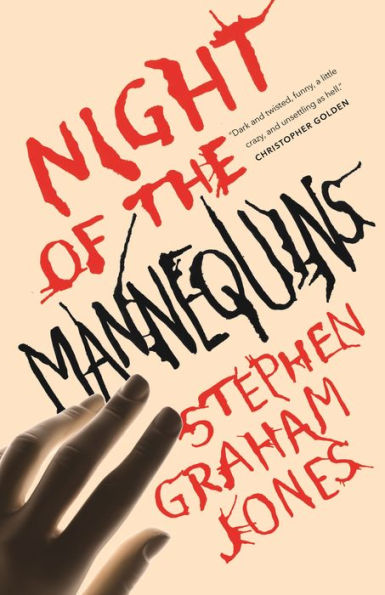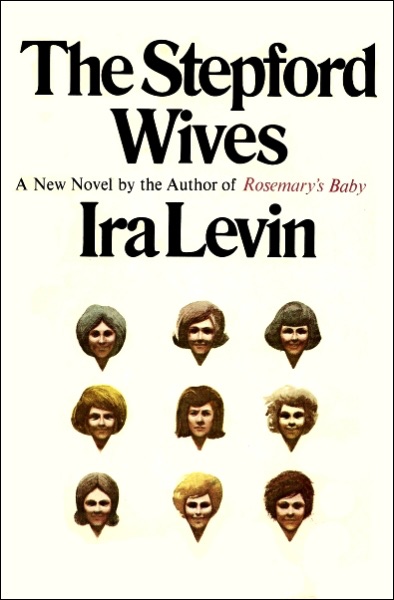“I like to watch women doing little domestic chores,” says Diz Coba, the creepily smug leader of the Men’s Club in Ira Levin’s 1972 SF paranoid feminist thriller The Stepford Wives. The women in Stepford scrub floors and clean counters; they straighten and dust and fix their makeup. “[T]hey even fill their [grocery] carts neatly!” as protagonist, and new Stepford resident, Joanna Eberhart realizes in horror.
The cleanly, ominous order of Stepford is an uncanny threat. But it’s also the structural aesthetic of the novel itself. The Stepford Wives, like the Stepford wives, is a flawless machine, every detail of the plot carefully arranged like a well-ordered kitchen. The frictionlessness, fussy regimentation is so insistent that it calls into question the novel’s sympathies. Is Levin, with Joanna, looking with horror into those symmetrically-ordered grocery carts? Or is he, with Coba, leaning against the wall, appreciating the smooth polish of perfection?
The plot of The Stepford Wives is so famous as to have become a meme, with the phrase “Stepford Wife” serving as the same type of pop cultural shorthand as terms like “Pod People” or “Mean Girls”. The Eberharts—Walter and Joanna and their two children—move from New York to the suburban Connecticut town of Stepford, where all the women are beautiful and obsessed with housework. Joanna watches in horror as her friends, fellow new arrivals Charmaine and Bobbie, give up their hobbies and embrace domesticity and complacent servitude to their husbands. She begins to suspect that the Coba-led Men’s Club is murdering the town’s women and replacing them with robots.
The Stepford Wives is told in third person, but you’re mostly inside Joanna’s head; she’s the central focus of sympathy and identification. What’s more, that point of identification is explicitly and consistently feminist. As I wrote last week, Levin’s 1967 novel Rosemary’s Baby, which is also about patriarchy and sexism, never mentions feminism or the feminist movement. But here, Joanna actively follows the work of Friedan and Steinem, and takes their lessons to heart. She argues with her husband about the Men’s Club’s no-women-allowed policies, and tries, with Bobbie, to start a women’s liberation organization in Stepford. She’s also a photographer; early in the novel she takes a picture of a Black man looking angrily at a cab that has refused to pick him up. Joanna’s art highlights injustice, just as Levin is trying to highlight injustice. They are, together, creating a picture of the bland, repressive power of white patriarchy.
Yet, when Levin describes Joanna’s social justice commitments, there’s more than a touch of sardonic skepticism. She takes that photograph of racist cab service in large part to advance her career: “There were plenty of markets for pictures dramatizing racial tensions,” she muses, and then thinks about what darkroom techniques she can use to best highlight the image’s drama. Racism, for Joanna, is, perhaps, an injustice to confront. But it’s also a career opportunity and a formal, technical challenge.
Buy the Book


Night of the Mannequins
Similarly, Levin’s picture of the evils of patriarchy is obviously a career opportunity for him. And it sometimes seem to take a backseat to the pleasures of his well-constructed paranoid plot. Peter Straub, in an introduction to the HarperCollins edition, praises the book for “the controlled composure of its prose and the jewel-like perfection of its structure.” He notes that the events of the book are on a strict timetable; it takes four months before new arrivals are Stepfordized, and the book “is like a great clock ticking away from September 4 to just before Christmas.”
The novel’s mechanism is meant to reveal more fine detail and gears within gears upon rereading. Why is Walter’s libido up after the first Men’s Club meeting? Why does illustrator Ike Mazzard, known for his renderings of beautiful women, draw all those sketches of Joanna? Why does a local hobbyist ask her to record common words for his accent studies? What’s in those boxes that the Men’s Club has shipped in? Each piece falls into place, with a pleasingly nightmarish click.
Straub says that the novel “satirizes its oppressors and their desires, not their victims.” That’s true to some extent. Walter’s furtive masturbation as he thinks about his future robot Joanna is sad and ridiculous as well as gross, and the conformist, perfectly coiffed women of Stepford are a bleak indictment of the boring men who have such boring dreams.
But in a novel so pleased with its own plot construction, there’s also an implicit admiration of the men’s efficiency, and of their success. Coba is called “Diz” because of his experience at Disney World creating animatronic dolls, and he and his colleagues have created a clean, efficient, and undefeatable system for turning women into obedient, dehumanized drones. That system is patriarchy. But it’s also Levin’s novel, in which those repulsive, boring guys are, after all, smarter than their wives.
The men’s intelligence and their success is perhaps most evident in the fact that the novel doesn’t even catch them at it. The husband’s final coup, and the novel’s, is that the patriarchal plot erases itself, leaving its effects, but no fingerprints on its victims upgraded bodies or downgraded minds. No one ever confesses, and the reader never sees the men do anything untoward.
Joanna at the end of the novel tries to run from home, and is captured by the men. They try to calm her, and Bobbie, Joanna’s friend who she thinks is a robot, offers to cut her own finger with a knife to prove she’s human. “Joanna went forward, toward Bobbie standing by the sink with the knife in her hand, so real-looking—skin, eyes, hair, hands, rising-falling aproned bosom—that she she couldn’t be a robot, she simply couldn’t be, and that was all there was to it.” Joanna is convinced that all her fears were wrong; she capitulates, condemning herself as mentally incompetent before robot Bobbie kills her.
Or, perhaps she capitulates mentally because she’s been wrong all along, and domesticity isn’t a plot at all. When we last see her she’s abandoned her dream of being a photographer (“I wasn’t especially talented”) and is filling her grocery cart perfectly. Maybe she’s a robot. Or maybe she’s just realized that women are happier as domestic drones. The book leaves it open. It’s final amazing clock-work accomplishment is to make a narrative that is both feminist and its evil patriarchal double all at once. Levin gets to have his perfect domestic fantasy drone and condemn her too.
This was all just a little too tricky for Hollywood. The 1975 film version of the novel is a lot less ambiguous, and also a lot more messy. In the movie, the men’s machinations come apart, literally, several times. One robot damaged in a car crash starts to behave oddly, and when Joanna (Katharine Ross) stabs robot Bobbie (Paula Prentiss) towards the end of the film, the replacement housewife starts repeating the same words and dropping coffee cups, revealing her inhumanity and dirtying her kitchen simultaneously. Joanna even gets a glimpse of her own finished robotic duplicate as Diz rants like a supervillain, spouting melodramatic, very un-Levinish dialogue at her. The movie is more crass and less well-constructed than the book. It also, not coincidentally, validates Joanna a lot more unequivocally. The men still win, but Joanna at least gets to bash her husband in the head with a poker in this version. She almost makes it out.
In the novel, by contrast, Joanna’s resistance is overcome so completely that even she isn’t exactly on her own side anymore… The author may not be, either. This isn’t to say that Levin thinks career women should abandon their ambitions for domestic happiness. But his novel does brilliantly show how disturbingly seductive perfection and order can be. Especially for men. And especially when that order is pure, all-encompassing patriarchy.
Noah Berlatsky is the author of Wonder Woman: Bondage and Feminism in the Marston/Peter Comics (Rutgers University Press).











What a perfect, and harsh, sentence.
This was an interesting angle of analysis for me, have never thought of this book in this more insidious way. But now I can’t unsee it.
Learning of the original novel’s conclusion makes me want to see a sequel called THE CHILDREN OF STEPFORD wherein the local villains have to grapple with the fact that their children have been raised by drones and STILL want to be more free than their Mothers & Grandmothers were … and not just the girls (the title is, of course, a nod to the fundamental childishness of the idea that one can preserve the world unchanged and unchanging indefinitely).
There was a movie called Stepford’s Children in the late 80’s. A family moves in and wants to turn there pesky defiant teens into robots too. The teens must escape the dastardly plot. Only some of the teens make it out of Stepford unscathed.